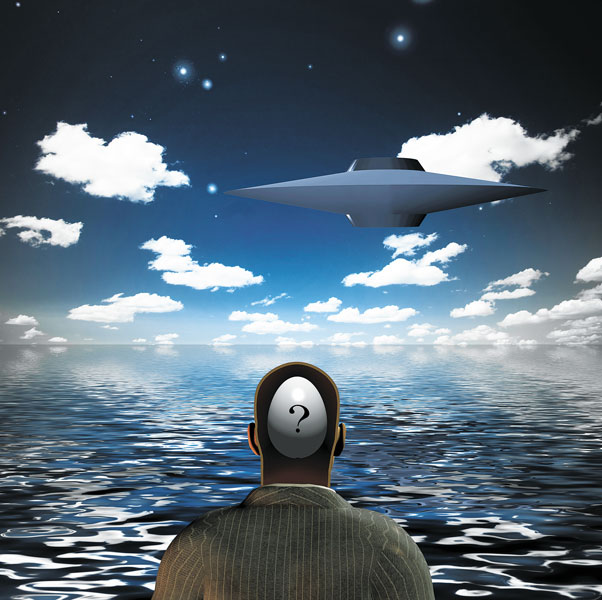David Bates: Other manifestations
The 17th Annual UFO Festival is upon us, which for UFO enthusiasts means alien costumes, games, lectures, films and live music.
It seems an ideal occasion to place the topic of UFOs in the context of science and, particularly, the way in which new and seemingly strange ideas emerge, germinate and eventually blossom into the reality of what we all know and take for granted.
script named author-bates-viewpoint not found
Thousands of years ago, in what were then considered the most advanced civilizations, people believed the Earth was flat. They didn’t just believe it. They "knew" it. Understandably so, after all, because to look at it, notwithstanding mountains here and there, it was obviously flat. Even though early Greek astronomers hypothesized that Earth was spherical, this wouldn't be established in the laboratory of real-world experimentation until the 1500s, when Magellen circumnavigated the globe. But for centuries, the prospect of sailing off the edge seemed well within the realm of possibility.
Fast-forward to the early 1600s. The Italian astronomer and physicist Galileo, upon careful examination of the night sky, determined that Copernicus must have been right: The Earth traveled around the sun, not the other way around. He published his theory, incurring the wrath of the Catholic Church. The scientist was subsequently tried, found guilty of hereticism, and imprisoned. Today, even very young children know that the Earth travels around the sun.
In 1827, the German physicist Georg Ohm, following much experimentation, published a book in which he basically described for the first time how electricity worked. Because his forumlas emerged from laboratory experimentation, which was not yet in vogue, Ohm's ideas were branded "a web of fancies." The German education minister at the time declared that Ohm, a university instructor, was "unworthy to teach science." Today, those who know something about electricity are familiar with Ohm's Law.
In the mid-1800s, an Austrian physician by the name of Ignaz Semmelweis suggested – a couple decades before germ theory – that hospital patients were dying all over the place because doctors didn’t wash their hands after handling cadeavers. His colleagues, feeling insulted, denounced the idea, figuring Semmelweis must literally be out of his mind. Semmelweis was thrown into an asylum, bound in a straitjacket, and beaten to death. Meanwhile, we’ve all learned how important it is to wash our hands.
In the early 1900s, little more than six years after the Wright brothers first got an airplane off the ground, a 27-year-old physics instructor named Robert Goddard was immersed in theoretical work with rockets. He launched his first such device in 1919 and proposed that they would eventually travel to the moon.
The U.S. press heaped scorn and ridicule on Goddard -- so much so that he was forced to retreat into more private work, and his funding dried up. The New York Times was particularly vehement: "Of course he only seems to lack the knowledge ladled out daily in high schools." The backlash against the young scientist was one reason Germany got a head start on rocketry with its V-2. Today, of course, astronauts have visted the moon multiple times, and even children have the opportunity to learn about rocket science by launching their own in fields and empty parking lots. Goddard, meanwhile, is known as the father of modern rocketry.
In the mid-20th century, the French astrophysicist and computer engineer Jacques Vallee became one of the first mainstream scientists to take UFOs seriously. He traveled around the globe, methodically and scientifically investigating the phenomenon, interviewing witnesses, doing archival research and organizing his vast store of information in a database.
Vallee’s books on the UFO problem make for fascinating reading. He argues (persuasively, in my opinion) that Unidentified Flying Objects are not vehicles operated by extraterrestrials from other planets who are studying human beings or Earth. Interestingly, he is as critical of most self-described ufologists as he is of those who dismiss or ignore the issue altogether.
Nevertheless, more than a quarter century of research led Vallee to conclude that for thousands of years, human beings in all cultures have had encounters with an intelligent and apparently non-human consciousness, an “other” that manifests in ways that defy the known laws of our physical sciences and cannot be universally explained away by the usual, comforting suspects: Lenticular clouds, weather balloons, Venus, etc.
UFOs, he insists, are an objectively real phenomenon that poses “an exciting challenge to our concept of reality itself.” Given the staggering implications for humanity, it's a challenge he believes ought to be openly discussed and studied by scientists.
Science magazines these days are filled with articles about scientists' evolving concept of reality. Consider some recent headlines from Scientific American: “Dark Matter May Be Much Weirder Than Physicists Thought,” “Beyond the God Particle,” "Is Space Digital?" and “The Case for Parallel Universes.” Clearly, concepts of reality are fair game in the realm of physics and cosmology.
But the prevailing view in the scientific community is that UFOs are “pseudo-science.” Fit for costumed parades, Hollywood films and the fringes of the Internet only. But not for "real" science.
Perhaps the most vocal spokesman for this view is another astrophysicist, Neil deGrasse Tyson, one of the most visible and media-savvy scientists in the United States.
He sneers at UFO witnesses and pokes fun at those who, like Vallee, say something is going on that has not been sufficiently explained, much less studied. His UFO-debunking rant, delivered with bemused exasperation, begins with a triumphant reminder that the “U” in UFO stands for “unidentified.”
“If you don’t know what it is,” he thunders, “that’s where your conversation should stop!”










Comments